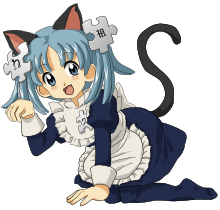A catgirl (猫娘, nekomusume) is a female kemonomimi character with feline traits, such as cat ears (猫耳, nekomimi), a cat tail, or other feline characteristics on an otherwise human body. They are not individuals who are literal cats but individuals who only look superficially feline.[1] Catgirls are found in various fiction genres, particularly in Japanese anime and manga.[2] Catboy is a term for the male equivalent of said character type.

History edit
The oldest mention of the term nekomusume comes from an 18th-century misemono (見世物) in which a cat/woman hybrid was displayed.[3] Stories of shape-shifting bakeneko prostitutes were popular during the Edo period.[3] The popularity of the nekomusume continued throughout the Edo and Shōwa periods, with many tales of cat/woman hybrids appearing in works such as the Ehon Sayoshigure (絵本小夜時雨) and Ansei zakki (安政雑記).[3]
In Kenji Miyazawa's 1924 work, Suisenzuki no Yokka (水仙月の四日, literally The 4th of Narcissus Month) is the first modern day example of a beautiful, cat-eared woman.[4] In 1936, the nekomusume experienced a revival in kamishibai.[3] The first anime involving catgirls, titled The King’s Tail (Ousama no Shippo), was made in 1949 by Mitsuyo Seo.[citation needed] In America, the DC Comics character Catwoman first appeared in 1940, and Cheetah first appeared in 1943.[5]
Catgirls were further made popular in 1978 manga series The Star of Cottonland, by Yumiko Ōshima.[6] By the 1990s, catgirls were common in Japanese anime and manga.[7] Catgirls have since been featured in various media worldwide. Enough of a subculture has developed for various themed conventions and events to be held around the world, such as Nekocon.[8]
Reception edit
Japanese philosopher Hiroki Azuma has stated that catgirl characteristics such as cat ears and feline speech patterns are examples of moe-elements. Azuma argued that although some otaku sexual expression involves catgirl imagery, few otaku have the sexual awareness to understand how such imagery can be perceived as perverted.[7][9] In a 2010 critique of the manga series Loveless, the feminist writer T. A. Noonan argued that, in Japanese culture, catgirl characteristics have a similar role to that of the Playboy Bunny in western culture, serving as a fetishization of youthful innocence.[10]
See also edit
References edit
- ^ "Cat Girl". TV Tropes. Retrieved 2024-04-25.
- ^ Okum, David (2004-03-24). "Cat Girl". Manga Madness. F+W Media. p. 72. ISBN 978-1-58180-534-5.
- ^ a b c d Davisson, Zack (2017). Kaibyō : the supernatural cats of Japan (First ed.). Seattle, WA: Chin Music Press. ISBN 978-1-63405-916-9. OCLC 1006517249.
- ^ "Suisenzuki no yokka". www.aozora.gr.jp (in Japanese). Archived from the original on September 23, 2015. Retrieved March 15, 2015.
- ^ Wallace, Daniel (2010). "1940s". In Dolan, Hannah (ed.). DC Comics Year By Year A Visual Chronicle. Dorling Kindersley. p. 31. ISBN 978-0-7566-6742-9.
The first issue of Batman's self-titled comic written by Bill Finger and drawn by Bob Kane, represented a milestone in more ways than one. With Robin now a partner to the Caped Crusader, villains needed to rise to the challenge, and this issue introduced two future legends: the Joker and Catwoman.
- ^ Berndt, Jaqueline (1995). Phänomen Manga : Comic-Kulture in Japan (in German). Berlin: Edition q. p. 111. ISBN 978-3-86124-289-5.
- ^ a b Azuma, Hiroki (2009). Otaku: Japan's database animals. Translated by Abel, Jonathan; Kono, Shion (English ed.). Minneapolis: University of Minnesota Press. pp. 47, 89. ISBN 978-0-8166-6800-7. OCLC 527737445.
- ^ "After Action Report". The Virginian-Pilot. 2007-11-07. Archived from the original on 2016-09-14. Retrieved 2013-02-03.
- ^ Galbraith, Patrick W. (31 October 2009). "Moe and the Potential of Fantasy in Post-Millennial Japan". Electronic Journal of Contemporary Japanese Studies. 9 (3). Archived from the original on 2019-10-25. Retrieved 2018-05-23.
- ^ Noonan, T. A. (Fall 2010). ""I Can't Get Excited for a Child, Ritsuka": Intersections of Gender, Identity, and Audience Ambiguity in Yun Kôga's Loveless" (PDF). MP: An Online Feminist Journal. 3 (2). ISSN 1939-330X. Archived (PDF) from the original on 12 January 2016. Retrieved 10 February 2013.